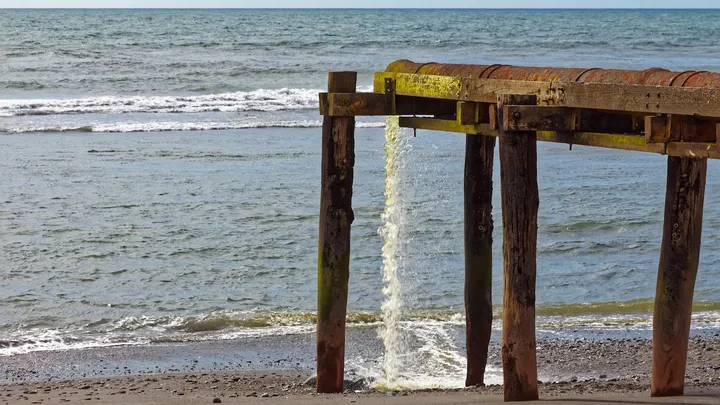More than half of US beaches have been shown to have unsafe levels of fecal contamination, researchers say

Please come on in; the water’s fine… or is it?
Beaches, which are considered one of America’s greatest natural attractions, receive an estimated 400 million visitors annually, as reported by the United States Lifesaving Association.
However, a recent study indicates that the country’s coastlines might harbor hidden health risks.
According to the annual Safe for Swimming report by Environment America, a research, education, and advocacy group based in Boston, approximately half of the U.S. beaches examined in 2022 exhibited potentially unsafe levels of fecal contamination.
Feel free to take a dip; the water is safe.
Out of the 3,192 beaches tested nationwide, 55% were found to have unsafe levels of fecal contamination on at least one day, as stated in the report. Additionally, 363 beaches (equivalent to one out of every nine beaches tested) exhibited potentially unsafe levels of fecal contamination on at least 25% of the testing days.
The researchers utilized the Beach Action Value (BAV), a tool employed by the Environmental Protection Agency (EPA) to determine the safety of beach water. The BAV relies on measured bacteria levels to issue advisories or closures of beaches.
Beaches were classified as “unsafe” when the test results surpassed an estimated illness rate of 32 per 1,000 swimmers.
The report data, collected on May 31, was sourced from the National Water Quality Monitoring Council’s Water Quality Portal. This portal incorporates the available test outcomes for all U.S. beaches listed under the BEACH Act.
Kelly Johnson-Arbor, a medical toxicologist at the National Capital Poison Control Center in Washington, D.C., stated that the BEACH Act of 2000, which is a part of the Clean Water Act, requires states to follow water safety regulations. These regulations are in place to prevent excessive contamination of coastal waters by disease-causing bacteria such as E. coli and Enterococcus species. Johnson-Arbor provided this information to Fox News Digital. It’s important to note that Johnson-Arbor was not directly involved in the report conducted by Environment America.
Varying numbers across the nation
While the nationwide rate of unsafe contamination stood at approximately 55%, the figures varied across different regions of the country.
The Gulf Coast beaches exhibited the highest levels of contamination, with 84% of them recording potentially unsafe water on at least one testing day in 2022.
Following closely were the West Coast beaches, with 70% of them being identified as contaminated, according to the report.
Among the Great Lakes beaches, 63% were found to have unsafe levels on at least one day.
For East Coast beaches, the proportion of contaminated beaches was 48%.
In Alaska and Hawaii, 24% of the beaches registered unsafe levels on at least one day.

The results showed significant variations among states, which can be attributed to the frequency and extent of their testing.
The report provides details on the specific beaches tested in each state, including the total number of testing days and the number of days where potentially unsafe contamination levels were detected.
According to Johnson-Arbor, in 2022, there were nearly 9,000 instances of beach closings or water advisories due to contamination from pollution sources. More than half of these advisories or closings lasted for a minimum of three days.
The EPA recently released its own summary of beach closings and advisories from the 2022 swimming season, based on information provided by the states and territories that receive BEACH Act grants from the agency.
According to the EPA, these jurisdictions conducted water sampling at swimming beaches to determine if levels of specific indicator bacteria exceeded the applicable water quality standards. In a statement to Fox News Digital, the EPA stated, “Program beaches on U.S. coasts and along the Great Lakes were open and safe for swimming 92% of the time in 2022.” The term “program beaches” refers to those beaches that have established a notification system to inform the public about unsafe swimming conditions resulting from bacterial contamination.
Potential hazards of polluted beaches
The EPA states that individuals who swim in waters contaminated with fecal matter are at risk of developing gastrointestinal (GI) illnesses. These illnesses can manifest as symptoms such as diarrhea, nausea, vomiting, stomach cramps, low-grade fever, muscle aches, or headaches, as reported by the Mayo Clinic.

According to Johnson-Arbor’s statement to Fox News Digital, microbial contamination in recreational waterways is associated with an increased occurrence of gastrointestinal illnesses, skin problems, eye infections, and other diseases. Additionally, people can contract gastrointestinal illnesses, including hepatitis A and norovirus, by consuming shellfish that were harvested from polluted waters.
It is worth noting that gastrointestinal illnesses most commonly occur when individuals ingest contaminated water.
Johnson-Arbor emphasized the importance of preventing the spread or contraction of gastrointestinal germs by advising individuals not to swim if they have diarrhea and to refrain from swallowing water from lakes, streams, oceans, or other recreational waterways. She also recommended staying out of the water if one has an open wound.
Dr. Marc Siegel, a medical contributor to Fox News and a professor of medicine at NYU Langone Medical Center, echoed these precautionary measures.
“Severe Illnesses, Infections and Diarrhea in Contaminated Water Chan Chose.”
Dr. Marc Siegel, in an interview with Fox News Digital, highlighted the potential for serious illness, infection, and diarrhea resulting from exposure to contaminated water. He advised individuals to practice thorough washing and showering after swimming and to avoid submerging themselves underwater if they have underlying health conditions or if the bacterial content of the water is high.
Johnson-Arbor recommended checking with the local health department or visiting its website to inquire about any active advisories for a specific beach due to poor water quality.
What causes beach pollution?

According to a report by Environment America, the bacteria found in seawater primarily originate from sources such as stormwater runoff, sewage overflows, and, in certain areas, manure from industrial livestock production.
While the available data does not allow us to determine if beach pollution is worse now compared to previous years, John Rumpler, the clean water program director for Environment America based in Boston, expressed concerns about several troubling trends that contribute to the likelihood of beach pollution. He stated this in a statement provided to Fox News Digital.
The report highlights that one of the major factors contributing to water pollution is the increased development of homes, roads, and parking lots. This development leads to a greater amount of polluted stormwater ending up in oceans. The Office for Coastal Management in Charleston, South Carolina, reports a 12% increase in land development in coastal areas since 1996, totaling more than four million acres. The process of development often involves the paving over of wetlands and forests that would otherwise absorb stormwater, leading to overwhelming sewer systems and runoff into streams, as explained by Rumpler.
Additionally, the report points out that aging, inadequate, or poorly maintained sewage systems also contribute to poor water quality. These systems fail to effectively filter out disease-causing bacteria and viruses. Rumpler notes that increasingly severe storms can quickly overwhelm sewage systems, resulting in overflows.
Other common sources include waste from pets and other animals, as well as runoff from people’s daily activities, such as lawn irrigation, according to Johnson-Arbor.
“These types of flows can cause fecal bacteria and other microbes to build up in freshwater, seawater, and even sand,” she told Fox News Digital.
Factory farms are also a major source of fecal pollution, as heavy rains carry manure from livestock into nearby rivers, creeks, and streams, where they flow into seawater, the report said.
“In order to have safe beaches and other waters for swimming, we must protect and restore our natural infrastructure and continue to repair our constructed sewage systems,” Rumpler told Fox News Digital.
Take precautions but enjoy nature, say experts
Keith Lambert, a 30-year pollution control veteran who has been involved in air cleaning projects for companies including Tesla, Cargill and Lockheed Martin, was not involved in the Environmental America report but did not find the results surprising.
“I always say look at two or three sources before making a final decision or designation because raw data doesn’t lie, but it varies by a lot of criteria,” California-based Lambert told Fox News Digital.
Contaminated water is one of several potential sources of contaminants, Lambert said.
“The short, hard truth is that you can pick up a bad actor — germs, species or bacteria — from any number of sources on any given day, one of which is the body of water you’re wandering through,” Lambert says. .
“It all comes down to being in the wrong place at the wrong time,” he continued. “Our ecosystem is organic, and we are constantly contributing inorganic and harmful elements to it, so this is a recipe for increased negative interactions.”
While he believes water pollution is a real problem, Lambert emphasized that people can and should continue to enjoy the nation’s beaches with the right precautions.
“Go live, swim, go into nature, it’s here for our enjoyment,” he said. “Simple things like washing your hands after climbing or taking a good shower with soap and water after swimming are practical measures.”
Take precautions but enjoy nature, say experts

Keith Lambert, a 30-year veteran in pollution control who has worked on air cleaning projects for companies such as Tesla, Cargill, and Lockheed Martin, was not involved in Environment America’s report; however, he found the results unsurprising.
According to Lambert, it is always advisable to consult multiple sources before making a final decision or conclusion, as raw data is objective but can vary depending on various factors. Lambert, who is based in California, shared his perspective with Fox News Digital.
Lambert stated that polluted water is just one of several potential sources of contaminants. He believes that on any given day, one can encounter harmful actors such as germs, species, or bacteria from various sources, including the body of water in which they are present. He explained that it often boils down to being in the wrong place at the wrong time. Lambert emphasized that our ecosystem is organic, constantly impacted by inorganic and harmful elements, leading to increased negative interactions.
While acknowledging water contamination as a genuine problem, Lambert stressed that people can and should still enjoy the nation’s beaches by taking appropriate precautions. He encouraged individuals to engage in outdoor activities, swim, and immerse themselves in nature, as it is meant for our pleasure. Lambert highlighted practical measures like washing hands after a hike and thoroughly showering with soap and water after swimming as essential actions to be taken.
Know how to prevent pollution

To address sewage pollution, Environment America has called for several measures. These include the repair, modernization, and expansion of sewage systems, the establishment of pollution limits for sewage treatment plants, and the enforcement of proper maintenance for residential septic systems.
In order to mitigate runoff pollution, the report emphasizes the importance of public investment in natural and green infrastructure features. These features include rain barrels, permeable pavement, urban green space, and green roofs, which can help manage stormwater and reduce the amount of pollutants entering waterways.
The report also recommends implementing new farming policies to prevent manure pollution, protecting wetlands that act as natural filters for pollutants, and expanding and enhancing beach testing programs to ensure water quality.
Individuals can contribute to reducing their impact by utilizing rain barrels, creating gardens and planting trees that can absorb stormwater, and maintaining septic systems to prevent leakage into groundwater, according to Rumpler, a representative of Environment America.
In 1972, the federal government established the Clean Water Act (CWA) to regulate pollutants in U.S. waters. The Environmental Protection Agency (EPA) developed programs under the CWA to control pollution and provide recommendations for maintaining water quality.
Rumpler highlighted that fifty years ago, the nation united to declare that all waterways should be safe for swimming. Most Americans still believe in the value of clean water and expect government officials to take decisive actions to protect it.

